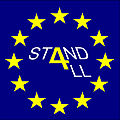The Basic Right of Accessibility
The basic rights of persons with disabilities include equality and accessibility. Below are three examples of policy and legislation that cover these basic rights.
United Nations
In 1994 the United Nations (UN) adopted the Standard Rules on the Equalization of Opportunities for Persons with Disabilities. Although not a legally binding instrument, the standard rules represent a strong moral and political commitment for governments to take action to attain equalisation of opportunities for persons with disabilities. The rules serve as an instrument for policy-making and as a basis for technical and economic cooperation.
In December 2006, the United Nations adopted the
Convention on the Rights of Persons with Disabilities (CRPD).
This convention establishes a range of rights and responsibilities.
It establishes rights for persons with disabilities and responsibilities for governmental and private sector players from signatory and ratifying countries.
In cooperation with the International Telecommunication Union (ITU) and the Global Initiative for Inclusive ICTs (G3ict),
the United Nations developed a toolkit for policy makers
that addresses the Convention’s provisions regarding accessibility to information and communication technologies (ICTs):
see the e-Accessibility Policy Toolkit for Persons with Disabilities.
European Union
The European Union and its member states have confirmed their view that disability is a broad human rights issue. They set up an EU Disability Strategy that is built upon three pillars:
- EU anti-discrimination legislation and measures, which provide access to individual rights;
- eliminating barriers in the environment that prevent people with disabilities from exercising their abilities;
- mainstreaming disability issues.
The Stand4All training fits in this framework.
United States of America
The United States have significant regulation to eliminate discrimination against persons with disabilities. This is not included in the Stand4All training because it is not European legislation. However, it shows how regulation is also possible. More information is available on websites dedicated to the Americans with Disabilities Act and Section 508 of the Rehabilitation Act.
Standards
Simply put, a standard is an agreed, repeatable way of doing something. It is a published document that contains a technical specification or other precise criteria designed to be used consistently as a rule, guideline, or definition. Standards help to make life simpler and to increase the reliability and the effectiveness of many goods and services we use. Standards are created by bringing together the experience and expertise of all interested parties such as the producers, sellers, buyers, users and regulators of a particular material, product, process or service.
A standard is a document established by consensus that provides rules, guidelines or characteristics for products, services and systems. Thanks to standards, simple things like the size of a credit card — and all the products and services related to it — can be the same everywhere. If there’s no standard for the services or product, there can be differences between these products and services. These differences vary in terms of safety, security, compatibility etcetera.
Standards can help us to ensure public safety because they can ensure that products and services meet their safety requirements. Because of these safety standards, the public can live and work in a safer, sustainable and a more reliable environment.
In addition to the safety aspect, it is also of great importance that standards can reduce costs; change is easy to implement when heterogeneous resources work together.
Standards also improve quality of products and services as they anticipate and respond to changes and developments in the market, customer demand and business priorities. Standards also improve quality of goods as they use value from business assets, including people, process, and technology.

